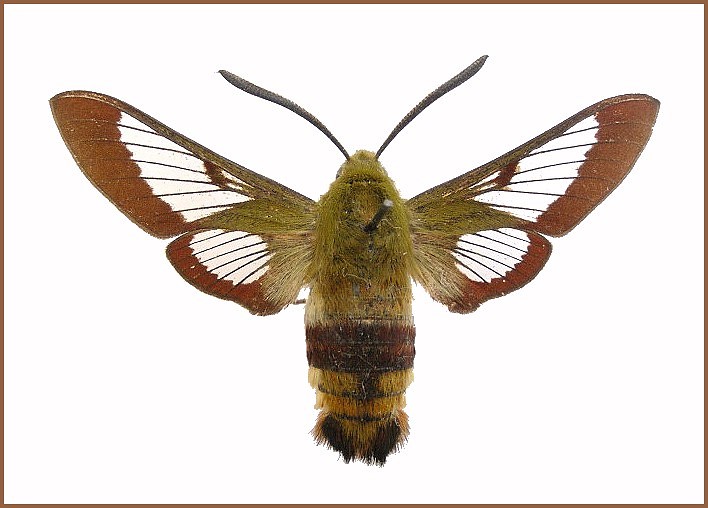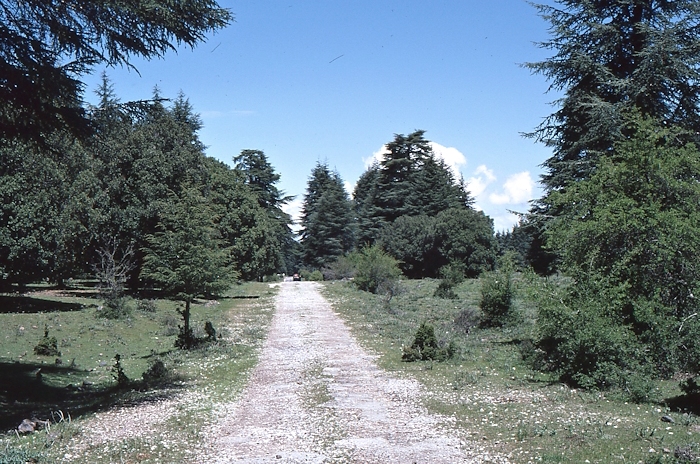UK: Broad-bordered Bee Hawkmoth, F: Sphinx Gazé; Sphinx du Chèvrefeuille, D: Hummelschwärmer, RUS: Brazhnik Shmelevidnyi zhimolostnyi, S: Humlelik Dagsvärmare, NL: Glasvleugelige Pijlstaart, CZ: Dlouhozobka chrastavcová; Dlouhozobka zimolezová, H: dongószender, E: cristalina borde estrecho; esfinge abejorro de orla ancha, PL: Fruczak bujankowiec, FIN: Kuusamakiitäjä, I: Sfinge fuciforme, HR: širokorubi bumbarasti ljiljak, DK: Bredrandet humlebisværmer, N: Bredkantet humlesvermer, EST: Kimalas-lottsuru.
Haemorrhagia fuciformis jordani Clark, 1927, Proc. New Engl. zool. Club 9: 105.Type locality: Ras-el-Ma, Morocco.
(Taxonomic note. Although very close, recent DNA barcoding studies have demonstrated that Hemaris fuciformis jordani is sufficiently distinct from Hemaris fuciformis fuciformis (Linnaeus, 1758) to warrent subspecific status. However, very similar-looking populations can be found in the montane coniferous forests of southern Spain, central Greece and Turkey. This requires further study.)
Holarctic; western Palaearctic region. Pleistocene refuge: Monocentric -- Mauritanian subsection of the Mediterranean refuge. Part of the present-day relict Mauritanian faunal element centred on the Middle and High Atlas Mountains (see de Lattin, 1967).

Wingspan: 45--51mm. Larger than Hemaris fuciformis fuciformis; many specimens are also darker in colour with small dentate areas along the wing margin.
Diurnal. In Morocco, frequents damp montane forest and scrub, especially areas of deciduous oak (Quercus spp.) with patches of Lonicera growing on the forest floor. Adults are partial to the flowers of thistles.

Bivoltine; April/May and June/July.
OVUM: Small (1.1 x 1.0mm), pale glossy green, spherical. Laid singly on the underside of the older leaves of its hostplant.
LARVA: Full-fed 42--48mm. On hatching, the 3mm-long, whitish yellow larva rests along the midrib on the underside of a leaf, occasionally nibbling oval holes in the latter. Most feed at night, resting during daylight hours in a typical sphinx-like attitude. Fully grown, many have reddish spots and blotches bordering the dorso-lateral line and spiracles which, combined with a very rough, tubercled skin, camouflage the larva well. At this stage it generally sits under a twig. If disturbed or alarmed, it will drop to the ground, although not as readily as Hemaris tityus (Linnaeus, 1758).
Commonly found during May, June, August and early September.
Hostplants. Species of Lonicera, particularly small clumps growing on the ground under trees..
PUPA: 25--30mm. Larger than those of Hemaris fuciformis fuciformis: blackish brown with glossy highlights and brown intersegmental cuticle. Formed on the ground in a loosely spun silken cocoon interwoven with debris. The overwintering stage.
None recorded.
Confined to the Atlas Mountains of Morocco and Algeria (Oberthür, 1916; Rougeot & Viette, 1978; Rungs, 1981).
Extra-limital range. None.
As subsp. Hemaris fuciformis fuciformis, from mountain refugia in southern and central parts of the Iberian Peninsula through Europe to the Ukraine, Urals, northern Kazakhstan, western Siberia and the Altai Mountains. Thence eastwards through the Pamirs, Hindu Kush and north-west Pakistan, across southern Siberia, southern Yakutia/Sakha and Transbaikalia to the Russian Far East and Sakhalin Island. Also central Greece, northern Turkey, the Caucasus, northern Afghanistan and the Tian Shan of Tajikistan. Absent from Ireland, Scotland, northern Scandinavia and Arctic Russia; however, recorded from Sardinia and Sicily.
 Return to species list
Return to species list